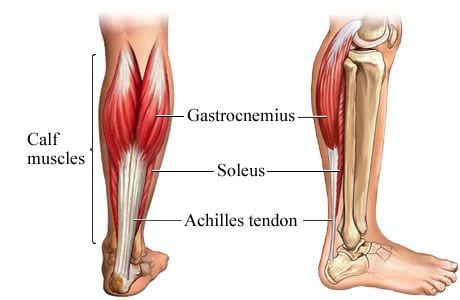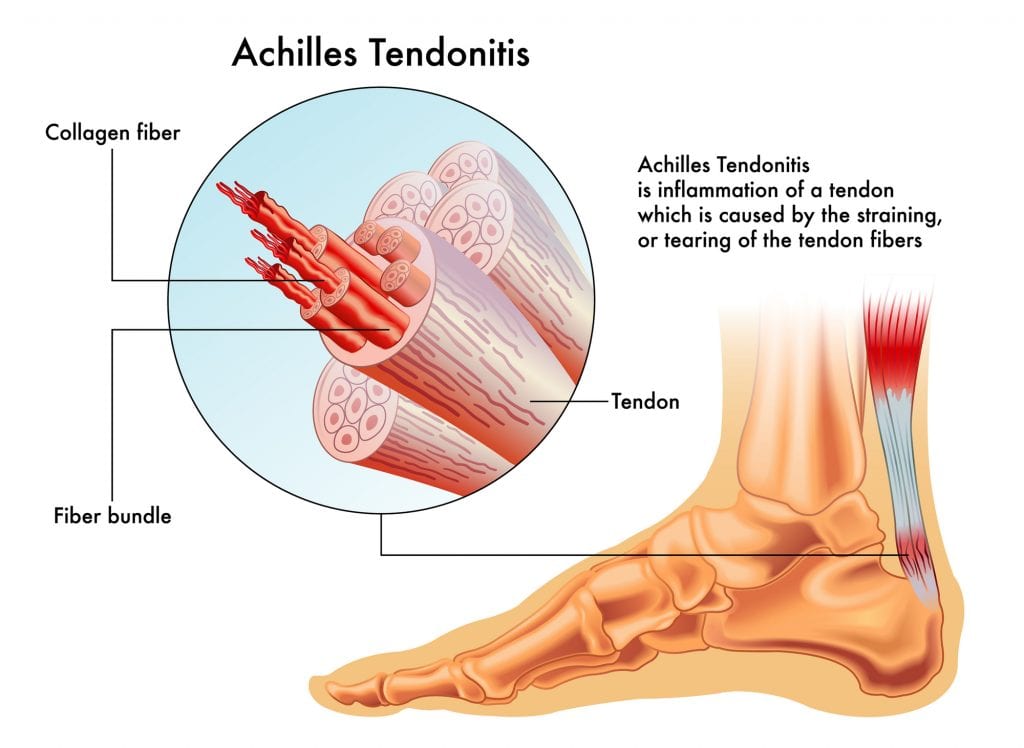
What is the Achilles Tendon?
The Achilles Tendon is a thick, fibrous band of connective tissue, that connects the calf muscle to the heel bone (calcaneus).

Achilles Tendiniitis
Achilles tendinitis is caused by inflammation of Achilles tendon causing pain, swelling and irritation. There are two main types.
Achilles Tendinopathy / Tendinosis

Achilles Tendinopathy is similar, however, it is a chronic condition without the earlier signs of inflammation, thought to be a degenerative process rather than inflammatory due to damage of the achilles tendon in the form of micro-tears due to overuse.
In both instances, due to over-stretching and tearing of the tendon fibres, inflammation occurs resulting in pain. This is called achilles tendinitis. If this condition is prolonged or repeated episodes of tendinitis occur, it results in a chronic condition where no inflammation take place but is replaced by thickening and swelling of the achilles tendon. The fibres then harden and even calcify restricting further movement, placing excess tress and tension on surrounding musculature and pain. In some cases, there may be evidence of bone growth ‘spurs’ forming from where the achilles tendon inserts into the bone of the heel.
Signs & Symptoms:
1. Gradual Onset of pain and stiffness over the tendon which will become worse with strenuous exercise
2. Tenderness of the tendon and heel
3. Swelling or thickening of the tendon may also occur
4. Pain on active movement of the ankle joint
5. Pain can occur at rest especially first thing in the morning when getting up.
If you feel a sudden snap or pop in the heel or back of the calf, it may be an achilles rupture.
Risk Factors / Causes:
1. Over Weight Increases the risk.
2. Flat Feet (Pronation Distortion Pattern)
3. Loss of Ankle Mobility
4. A sudden increase in training load
5. Tight Calf Musculature
6. Poor Footwear
7. Poor Running Technique
Treatment of Achilles Tendinopathy
Initial Plan:
1.No Barefoot Walking
2.Wear Orthotics
3.Before Moving after rest – write the alphabet with your foot in mid air.
4.No Running
5.Find a Local Supplier of Shockwave Therapy
Self Assessment:
So once you’ve taken care of the initial plan its time to assess yourself to figure out whats
causing your problem and what areas to focus on in your efforts to treat plantar fasciitis
and to prevent it coming back.
1. Foot Posture
If your feet look like this:
Then you need orthotics. Before you do anything else go see a local podiatrist or orthotist.
If your feet are a little less extreme then you may get away with not having orthotics, but in both cases you will want to do these following exercises to strengthen up your foot arches and work on the stability of your foot and ankle.

Fix 1. Towel Grab
Fix 2. 1 Leg Balancing
Fix 3. 1 Leg Toe Taps
2. Big Toe Extension
Do these tests to determine 1. If you lack big toe extension 2. If its due to joint immobility or soft tissue restriction.
If you lack big toe extension, as you walk you’ll roll your foot into over pronation to compensate for the lack of mobility. This is usually one of the biggest causes of bunions.
Fix: Joint Restriction – Calf Raises with big toe extension
Fix: Soft Tissue Restriction – Calf Stretches
& Plantar Fascia Rolling
3. Ankle Mobility
Do this test:
While doing the knee to wall test, if you have over 10cm then its good, 6cm or less is bad. Also look for symmetry between feet As above, if you lack ankle mobility, your compensatory pattern is to over-pronate.
Fix: Ankle Mobility Restriction – Knee Wall Tests
Fix: Ankle Mobility Restriction – Ankle Mobilisation
Fix: Soft Tissue Restriction – Calf Stretching
4. Pelvic Stability / Pronation Distortion Pattern
s your problem from further up? Do you lack hip stability and glute strength that you cant control the biomechanics of the lower limb. Does your knee fall inwards? Tibia Internally Rotate? Feet Drop in and over pronate?
Have a look at this picture and compare it to yourself.
Fix: Clams
Fix: Side Lying Leg Raises
Fix: Side Plank
Fix: Monster Band Walks
Fix: 1 Leg Squats
Fix: Bulgarian Split Squats
5. Glute Strength (or Weakness)
Following on from the previous point, are your gluten weak so that it allows the above posture to occur?
Test 1: Glute Bridge 60 seconds
Test 2: 1 Leg Glute Bridge 30 seconds
Achilles Tendon Repair & Conditioning
When it comes to the management of Achilles Tendinopathy / Tendinosis, a focus on progressive loading of the achilles tendon is paramount. Loading the tendon promotes tendon healing by essentially “re-injurying” the tendon and forcing the body to re-start the healing process.
Start Out with Isometric Exercises which provide a good analgesic effect on the tendon.
Hold the Calf Raise for 60seconds.
Repeat 3 times at varying heights.
Do regularly throughout the day.
Then when the pain subsides move onto more concentric and eccentric exercises which have the benefit of lengthening the tendon while strengthening.
These exercises are just a sample of many that can be used in a comprehensive treatment program. Set out to do 3 sets of 15 repetitions performed daily. If there is a bit of discomfort while doing it, its fine. Tendinosis / Tendinopathy is one of the few conditions in which its fine if theres a bit of discomfort as the tendon needs to be strengthened.
Summary
If you are suffering with achilles pain or even if you are not currently but noticed that you have flat feet or worse, the pronation distortion pattern shown above, then this is what your are going to do:
Initial Plan:
No Barefoot Walking Until Pain Free
Wear Orthotics
No Running until you can walk pain free.
Get Some Shockwave Therapy
Week 1
Roll Your Feet with a Tennis Ball / Spiky Ball 1-2 minutes per foot each day
Stretch Your Calves (Gastroc / Soleus) 6 times per day for 1 minute each
Week 2
Continue with above but add in:
Big Toe Extension
Ankle Mobility
Move into strengthening:
Isometric Calf Raises 1 minute x 3 times per day at least (hold with heel at different heights to work full range)
Towel Grabbing for 2 minutes twice per day
1 – Leg Balancing 1 Minute per side each day
Week 3
Replace Isometric Holds with:
Concentric Double Leg Calf Raises (3 x 20 per day – 3/3/3 Tempo)
Week 4
Replace Double Leg Calf Raises with:
Concentric Single Leg Calf Raises (3 x 15 per day – 3/3/3 Tempo)
Glute Strengthening: Glute Bridges / Clams / Side Planks / Monster Band Walks
Week 5
Eccentric Calf Raises:
Up on 2 and Lower on 1 (3 x 15)
6 second decent.
Week 6
Eccentric Calf Raises:
Up on 2 (box or step) and Lower on 1 (3 x 15) – 6 second decent.
Bench Eccentric Lowers (3 x 15)
Maintenance:
Roll Feet 3-4 times per week
Stretch Calves Daily
Ankle Mobility / Achilles Strengthening / Glute Strengthening 2-3 times per week.

